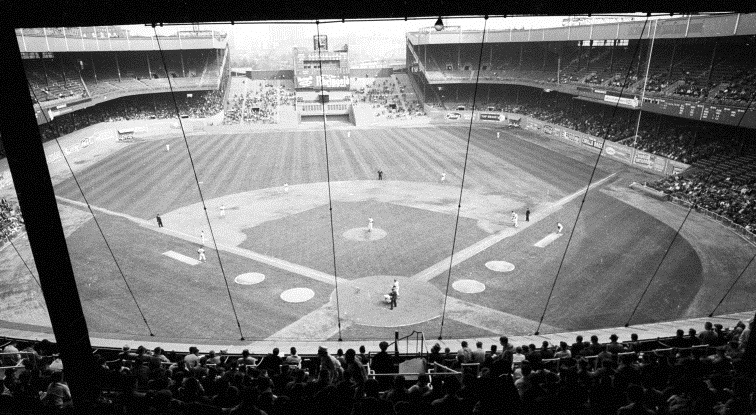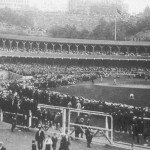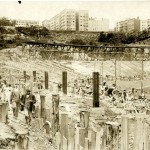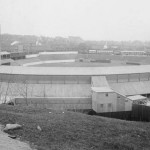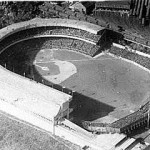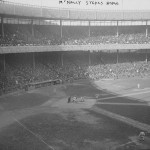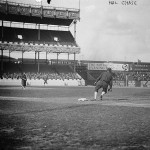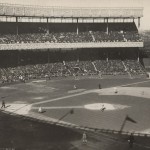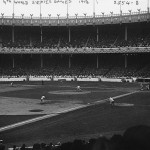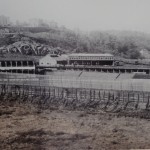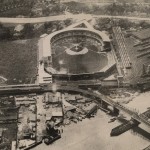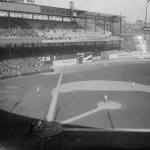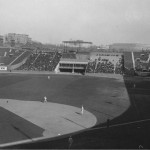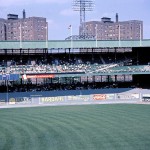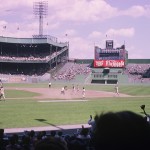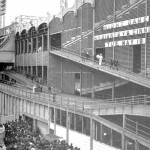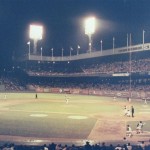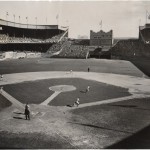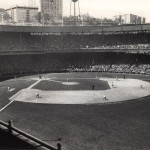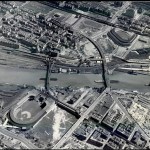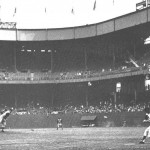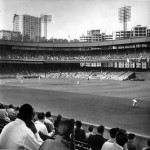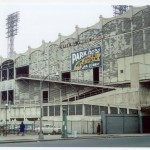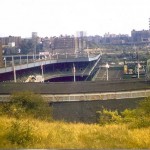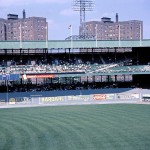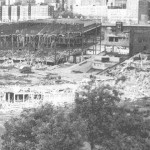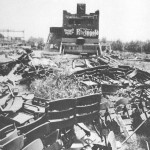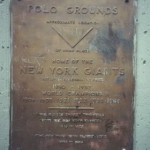Once situated between the Harlem River and Coogan’s Bluff in upper Manhattan was one of baseball’s most hallowed but unusual ballparks, Polo Grounds. This unique and storied ballpark was home to many legendary players, championship teams and memorable sports moments throughout its history. The name, Polo Grounds, was one used over several different ballparks beginning in the 1880s. The first incarnation of Polo Grounds was located at the northeast corner of Central Park between 100th and 112th streets where the game of polo was played. In 1880 John Day rented a parcel to construct a single tier grandstand for his baseball team, the Metropolitans, to play ball, beginning on September 29, 1880. In 1883 the New York Gothams were established as members of the National League. A second deck was added to the ballpark that year and the first Polo Grounds had a seating capacity of 12,000. Two baseball diamonds were located here and shared by both teams. In 1887 the Metropolitans folded and the following year Manhattan officials evicted the team as 111th street was constructed through the outfield. Renamed the Giants in 1885, the team played their last game here on October 13, 1888.
In 1889 the Giants moved to Coogan’s Hollow, a meadow below Coogan’s Bluff in Harlem, where the team played in several ballparks known as Polo Grounds over seven decades. Located at 155th and 157th Streets along 8th Avenue, the Giants played their first game at the next incarnation of Polo Grounds on July 8, 1889. Located along 157th and 159th Streets was Brotherhood Park, home of the Players League New York Giants. Side-by-side, there were two ballparks with two different teams that shared the same name. The Giants played their last game at the second Polo Grounds on September 30, 1890. In 1890 the Players League merged with the National League and the N.L. Giants bought and moved into Brotherhood Park in 1891. Renamed Polo Grounds, the Giants played their first game here on April 22, 1891. The next version of the Polo Grounds had a seating capacity of 16,000. The main double decked grandstand arched around homeplate and down the baselines. Bleachers were located in dead center field and 7,000 seats were added in 1908. By 1911, the ballpark had a seating capacity of 31,000 and was the largest stadium in baseball. Built of mainly wood, the ballpark suffered the same fate as nearly every other ballpark during this time. On April 14, 1911 a fire swept through the ballpark destroying everything except for the outfield bleachers.
| MEMORABLE MOMENTS AT THE POLO GROUNDS |
|
During this time, other teams throughout baseball were constructing new ballparks of steel and concrete. The Giants hired architect Henry Beaumont Herts to design a grand new ballpark for the team. Construction of the new $500,000 Polo Grounds started quickly and was partially completed, with a seating capacity of 16,000 when the New York Giants played their first game at the new ballpark on June 28, 1911. Construction of the ballpark continued throughout the 1911 season with the capacity increasing to 34,000 by the time the Giants played in the World Series. The new Polo Grounds featured a double decked grandstand that extended from home plate to half way down the left field line and down and around the right field foul pole. It had several decorative and unique features including ornate bas relif motifs lining the base of the upper deck, decorative relifs of all National League teams atop the upper deck façade and ironwork fence atop the roof that featured eagle statues every 20 feet.
Two years after opening the Polo Grounds inherited a new tenant when the New York Yankees moved into the ballpark in 1913. The dimensions at the Polo Grounds were one of the most quirkiest attributes of the ballpark and have never been seen at any ballpark since. The distances to the foul poles were short, 277 in left field and 258 feet in right field, the distance to centerfield was monstrous, ranging from 433 feet from homeplate when the ballpark opened to 505 feet during its history. Polo Grounds was a hitters paradise with the exception of centerfield. A pop fly down either line could easily become a homerun. After the Yankees acquired Babe Ruth in 1920 they won the 1921 and 1922 American League pennants. They easily outdrew the Giants, much to the chagrin of Giants owner John McGraw. After the 1922 season McGraw evicted the Yankees from the ballpark, leading them to build the greatest stadium in sports, Yankee Stadium, just a quarter mile south of the Polo Grounds.
Not to be outdone by the Yankee who built the 58,000 seat Yankee Stadium, the Giants expanded Polo Grounds in 1922 to seat nearly 55,000 fans. The entire ballpark was double-decked and enclosed except in centerfield. The grandstands were extended to the 2,300 bleachers that were on both sides of the clubhouse in centerfield. The left field upper deck overhung the playing field by 20 feet, shortening the dimensions to the second deck of left field to 257. After this expansion Polo Grounds looked like a horseshoe. Round behind home plate, the sides did not run parallel to the foul lines, but rather to a line drawn from home to second, extending straight into the power alleys before curving toward the middle in deep left and right centerfields. The center field wall ran straight across, except for a large cutout square in dead center that was the entrance to the clubhouses. Because the centerfield wall was 450 feet from homeplate, at one time there was a flower bed in centerfield until manager John McGraw ordered it removed. The bullpens were located in the outfield in play.
Polo Grounds changed very little during the rest of its tenure as a baseball stadium. By the 1950s the Giants were struggling to attract fans, Polo Grounds was falling into disrepair and tenement housing was built surround the ballpark. Due to these issues and failing to receive support for a new stadium, Giants owner Horace Stoneham announced on August 19, 1957 that the team would move to San Francisco the following year along with the Brooklyn Dodgers who would move to Los Angeles. The Giants played their last game at the Polo Grounds on September 29, 1957. Polo Grounds was reprieved when MLB awarded New York an expansion franchise, the Mets, who would play at the ballpark while their new stadium, Shea Stadium, was constructed. Nearly $350,000 was spent updating Polo Grounds that included installation of a new field, updated lighting and painting the ballpark in Mets colors of blue and orange. The Mets spent the 1962 and 1963 seasons here. The final game ever at Polo Grounds was on September 18, 1963. Polo Grounds was demolished on April 10, 1964. Several 30 story housing projects are located on the site where Polo Grounds was located. A plaque commemorates where the ballpark was once stood. The only other reminder of Polo Grounds is the John T. Brush Stairway which leads down Coogan’s Bluff to where the ballpark was located.
Polo Grounds was not only home to five championship New York Giants baseball teams, but home to the New York Yankees from 1913 to 1922, the New York Giants football team from 1925 to 1955, the New York Titans/Jets from 1960 to 1963. It was also the site of many famous boxing matches including the 1923 heavyweight championship between Jack Dempsey and Luis Firpo.

